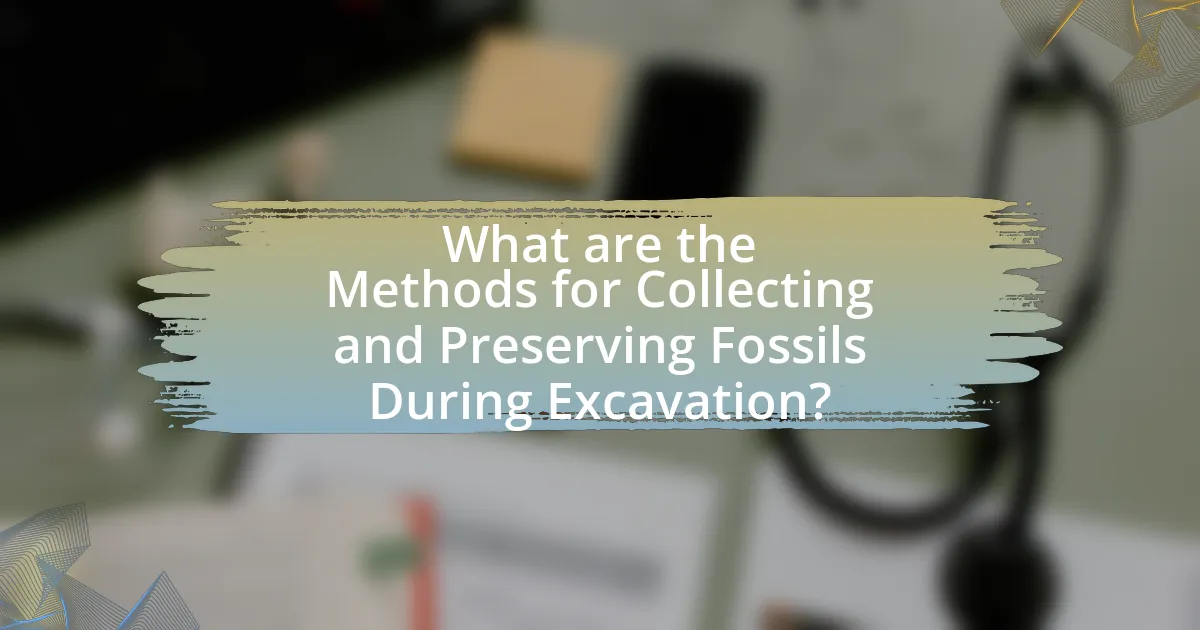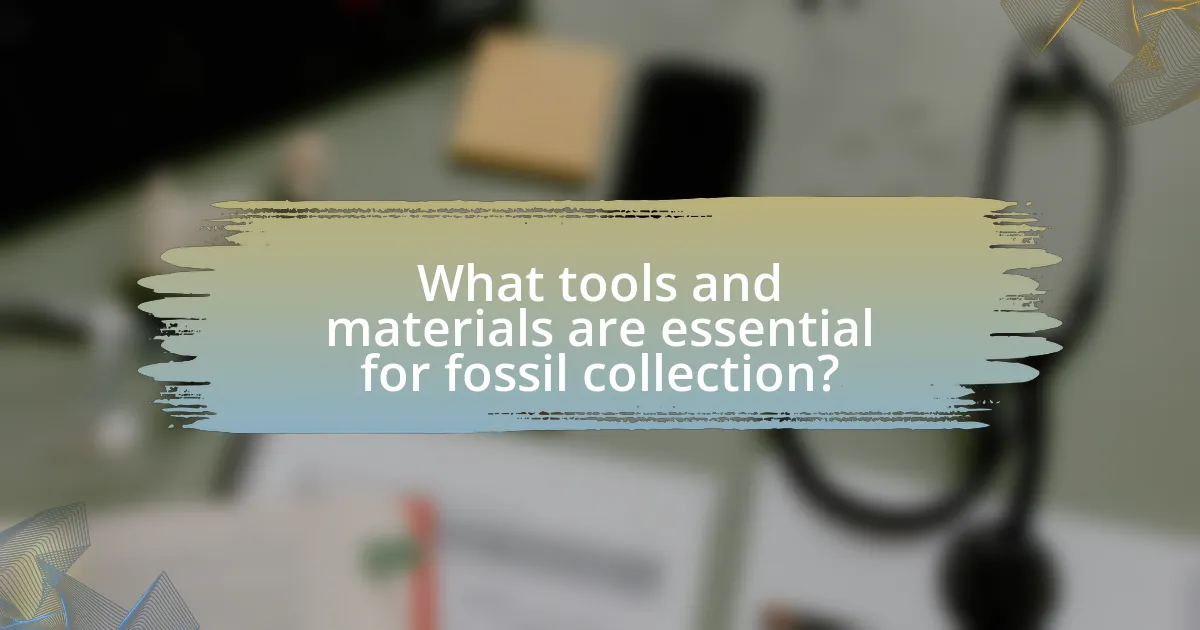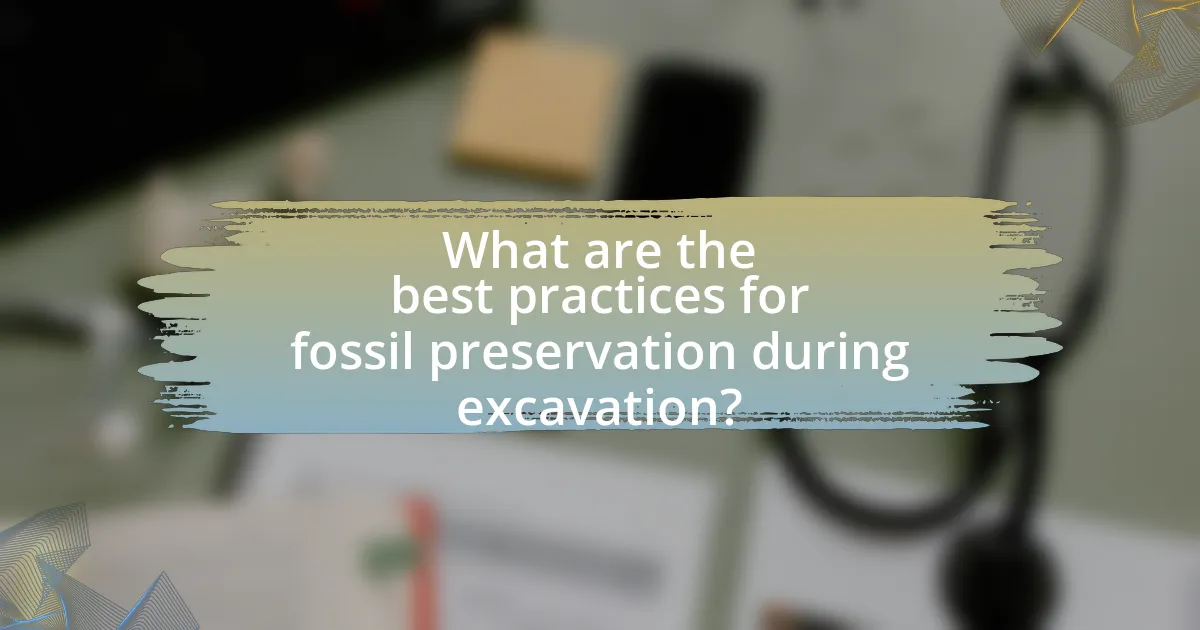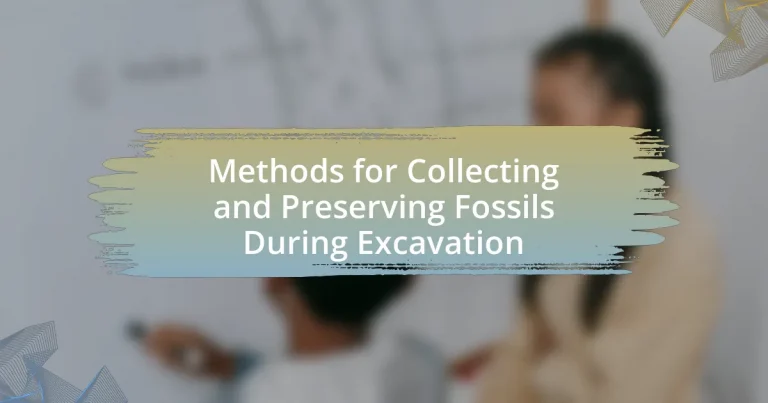The article focuses on the methods for collecting and preserving fossils during excavation, emphasizing the importance of careful excavation techniques, protective jackets, and proper storage conditions. It outlines various excavation methods, including hand, mechanical, and stratigraphic techniques, and discusses how these choices impact fossil integrity and preservation. Additionally, the article highlights essential tools and materials for fossil collection, the influence of environmental factors on preservation, and best practices for mitigating risks during excavation. Key strategies for ensuring the long-term integrity of fossils are also addressed, providing a comprehensive overview of effective paleontological practices.

What are the Methods for Collecting and Preserving Fossils During Excavation?
The primary methods for collecting and preserving fossils during excavation include careful excavation techniques, the use of protective jackets, and proper storage conditions. Excavation techniques involve using tools like brushes, chisels, and small picks to gently remove surrounding material without damaging the fossil. Protective jackets, often made from plaster or burlap, are applied to fossils in situ to stabilize them during transport. Proper storage conditions, such as maintaining consistent temperature and humidity levels, are crucial for preventing deterioration of the fossils post-excavation. These methods are validated by practices established in paleontological fieldwork, ensuring that fossils are preserved for future study and display.
How do different excavation techniques impact fossil collection?
Different excavation techniques significantly impact fossil collection by influencing the preservation quality and recovery rate of fossils. For instance, traditional hand excavation allows for meticulous removal of sediment, which minimizes damage to delicate fossils, while mechanical excavation can lead to increased fossil breakage due to the force applied. Studies have shown that hand tools can recover up to 90% of fossils intact, whereas mechanical methods may result in a loss of 30% or more due to fragmentation. Additionally, stratigraphic excavation techniques, which focus on preserving the geological context, enhance the understanding of fossil distribution and associated environmental conditions, thereby improving the scientific value of the collected specimens.
What are the most common excavation methods used in paleontology?
The most common excavation methods used in paleontology include hand excavation, mechanical excavation, and stratigraphic excavation. Hand excavation involves the careful removal of soil and rock using tools like trowels and brushes, allowing for precise recovery of fossils. Mechanical excavation utilizes machinery such as backhoes or excavators to remove larger volumes of material quickly, often in initial stages to expose fossil-rich layers. Stratigraphic excavation focuses on understanding the layers of sediment and rock, ensuring that fossils are collected in their original context, which is crucial for interpreting their geological and biological significance. These methods are validated by their widespread application in fieldwork, as documented in various paleontological studies and excavation reports.
How does the choice of excavation method affect fossil integrity?
The choice of excavation method significantly affects fossil integrity by determining the level of disturbance and the preservation of surrounding matrix. Techniques such as hand excavation minimize damage to fossils by allowing for careful removal of sediment, which helps maintain the structural integrity of the fossil. In contrast, mechanical excavation can lead to breakage or loss of delicate fossils due to vibrations and forceful removal of material. Studies have shown that fossils excavated using hand tools often retain more original features and context, as evidenced by successful fossil recovery in sites like the Hell Creek Formation, where meticulous methods have preserved fine details.
Why is preservation important during fossil excavation?
Preservation is crucial during fossil excavation because it ensures the integrity and scientific value of the fossils. Proper preservation techniques prevent damage from environmental factors, handling, and transportation, which can compromise the fossil’s structure and information. For instance, fossils can be sensitive to changes in temperature and humidity; without appropriate preservation methods, such as using protective jackets or stabilizing materials, they may deteriorate or lose critical data about their origin and context. This is supported by the fact that well-preserved fossils provide invaluable insights into past ecosystems, evolutionary processes, and geological history, making their preservation essential for ongoing research and education in paleontology.
What are the risks to fossils during the excavation process?
Fossils face several risks during the excavation process, including physical damage, contamination, and loss of context. Physical damage can occur from improper handling or the use of heavy tools, which may fracture or crush delicate specimens. Contamination can arise from exposure to environmental factors, such as moisture or pollutants, which can degrade the fossil material. Loss of context happens when fossils are not accurately recorded in relation to their geological setting, making it difficult to understand their significance. These risks highlight the importance of careful excavation techniques and proper documentation to ensure fossil integrity and scientific value.
How can proper preservation techniques mitigate these risks?
Proper preservation techniques can mitigate risks associated with fossil degradation by ensuring that fossils are protected from environmental factors and physical damage during excavation. Techniques such as using appropriate packaging materials, controlling temperature and humidity, and applying consolidants can significantly reduce the likelihood of fossil deterioration. For instance, studies have shown that fossils stored in controlled environments experience less cracking and flaking compared to those exposed to fluctuating conditions. Additionally, using specialized tools for excavation minimizes the risk of mechanical damage, preserving the integrity of the fossils.

What tools and materials are essential for fossil collection?
Essential tools and materials for fossil collection include a geological hammer, chisels, brushes, and a field notebook. The geological hammer is crucial for breaking rock and extracting fossils, while chisels help in precise removal of fossils from surrounding material. Brushes are used to clean fossils of dirt and debris, ensuring they are preserved in good condition. A field notebook is important for documenting the location, context, and details of each fossil find, which aids in research and analysis. These tools are standard in paleontology and are widely recognized for their effectiveness in fossil excavation.
What specific tools are used for fossil excavation?
Specific tools used for fossil excavation include trowels, brushes, chisels, and dental picks. Trowels are essential for carefully removing soil and sediment around fossils, while brushes help in cleaning the fossils without causing damage. Chisels are utilized for breaking away harder rock layers, and dental picks allow for precise extraction of delicate fossil structures. These tools are standard in paleontology, ensuring that fossils are excavated with minimal risk of damage, which is crucial for accurate scientific study and preservation.
How do different tools affect the precision of fossil collection?
Different tools significantly impact the precision of fossil collection by enhancing the accuracy and care with which fossils are excavated. For instance, hand tools like brushes and chisels allow for meticulous removal of surrounding matrix, reducing the risk of damaging delicate specimens. In contrast, heavy machinery can lead to the loss of smaller fossils or fragments due to their indiscriminate excavation methods. Studies have shown that using specialized tools, such as pneumatic hammers or dental picks, can improve the recovery rate of fragile fossils by allowing for more controlled and precise work. Therefore, the choice of tools directly influences the quality and integrity of fossil collections.
What materials are necessary for fossil preservation on-site?
Materials necessary for fossil preservation on-site include plaster bandages, burlap, and protective containers. Plaster bandages are used to create field jackets that encase fossils, providing structural support during transport. Burlap serves as a reinforcement layer, enhancing the durability of the plaster jackets. Protective containers, such as boxes or padded bags, are essential for safely storing fossils after excavation, preventing damage from environmental factors. These materials are critical in ensuring that fossils remain intact and undamaged until they can be properly analyzed in a laboratory setting.
How do environmental factors influence fossil preservation?
Environmental factors significantly influence fossil preservation by affecting the conditions under which organic remains are buried and mineralized. For instance, low oxygen environments, such as deep ocean floors or anoxic lagoons, slow down decomposition and enhance preservation. Additionally, rapid burial by sediment protects fossils from physical and biological disturbances, while mineral-rich waters can facilitate the replacement of organic material with minerals, creating more durable fossils. Studies show that fossils found in volcanic ash layers often exhibit exceptional preservation due to the rapid burial and low disturbance conditions provided by the ash.
What role does soil type play in fossil preservation?
Soil type significantly influences fossil preservation by affecting the conditions under which organic remains are buried and mineralized. Different soil types, such as clay, sand, and silt, have varying moisture retention, pH levels, and mineral content, which can either enhance or hinder the fossilization process. For instance, clay-rich soils tend to preserve fossils better due to their fine particles that reduce decay and promote anaerobic conditions, while sandy soils may lead to faster decomposition due to higher drainage and oxygen availability. Studies have shown that fossils found in clay deposits often exhibit better preservation quality compared to those in more porous soils, highlighting the critical role of soil type in the fossilization process.
How does weather impact the excavation and preservation process?
Weather significantly impacts the excavation and preservation process by influencing soil conditions, moisture levels, and temperature. For instance, heavy rainfall can lead to soil erosion, making excavation difficult and potentially damaging delicate fossil structures. Conversely, dry conditions can cause soil to harden, complicating the excavation process and increasing the risk of fossil breakage. Temperature fluctuations can also affect preservation; extreme heat may accelerate decomposition, while cold temperatures can preserve organic materials longer. Studies have shown that optimal excavation conditions typically occur in moderate, dry weather, which minimizes risks associated with both moisture and temperature extremes.

What are the best practices for fossil preservation during excavation?
The best practices for fossil preservation during excavation include careful planning, proper tools, and meticulous techniques. Excavators should first assess the site to identify fossil locations and stratigraphy, ensuring minimal disturbance. Using appropriate tools, such as brushes and small chisels, helps to delicately remove surrounding matrix without damaging the fossil. Additionally, applying consolidants, like polyvinyl acetate, can stabilize fragile specimens during extraction. Documenting the excavation process with photographs and notes provides context for future study. These practices are supported by guidelines from paleontological organizations, which emphasize the importance of preserving the integrity of fossils for scientific research.
What steps should be taken immediately after fossil discovery?
Immediately after a fossil discovery, the first step is to document the location and context of the find, including GPS coordinates and surrounding geological features. This documentation is crucial for understanding the fossil’s significance and for future research. Next, the fossil should be carefully excavated using appropriate tools to avoid damage, ensuring that the surrounding matrix is preserved to maintain the fossil’s context. After excavation, the fossil must be stabilized, often using consolidants to prevent deterioration. Finally, the fossil should be transported to a laboratory for further analysis and preservation, where it can be cleaned, cataloged, and stored under controlled conditions to ensure its longevity. These steps are essential for maintaining the integrity of the fossil and maximizing its scientific value.
How can fossils be safely transported from the excavation site?
Fossils can be safely transported from the excavation site by using protective packaging materials and secure containers. The process involves wrapping fossils in soft, cushioned materials such as bubble wrap or foam to prevent damage during transit. Additionally, sturdy boxes or crates should be utilized to hold the wrapped fossils securely, minimizing movement. Research indicates that proper handling and transportation techniques significantly reduce the risk of breakage, as demonstrated in studies by paleontologists who emphasize the importance of using appropriate materials and methods to preserve fossil integrity during transport.
What methods are effective for stabilizing fossils in the field?
Effective methods for stabilizing fossils in the field include the use of plaster jackets, consolidants, and careful excavation techniques. Plaster jackets provide structural support during transport, preventing breakage. Consolidants, such as polyvinyl acetate or other adhesives, help to reinforce fragile specimens by penetrating and binding the fossil material. Additionally, employing careful excavation techniques, such as using small tools and maintaining the surrounding matrix, minimizes stress on the fossil and reduces the risk of damage. These methods are widely recognized in paleontological practices for their effectiveness in preserving fossil integrity during fieldwork.
What common challenges arise during fossil excavation and preservation?
Common challenges during fossil excavation and preservation include the risk of damage to the fossils, environmental factors, and logistical issues. Fossils are often fragile, making them susceptible to breakage during excavation; for instance, improper handling can lead to significant loss of information. Environmental factors such as moisture, temperature fluctuations, and soil composition can also affect fossil integrity, as certain conditions may lead to deterioration or fossilization issues. Logistical challenges, including the accessibility of excavation sites and the availability of resources for preservation, further complicate the process. These factors collectively hinder effective fossil excavation and preservation efforts.
How can excavators address issues of fossil fragility?
Excavators can address issues of fossil fragility by employing careful excavation techniques and using specialized tools. These techniques include the use of soft brushes and hand tools to minimize damage, as well as the application of consolidants to stabilize fragile fossils before removal. Research indicates that using controlled excavation methods, such as stratigraphic excavation, reduces the risk of breakage, as it allows for the careful exposure of fossils in their geological context. Additionally, studies have shown that wrapping fossils in protective materials, like foam or plaster jackets, during transport significantly decreases the likelihood of damage.
What strategies can be employed to prevent contamination of fossils?
To prevent contamination of fossils, researchers can employ strategies such as using sterile tools, maintaining a controlled environment, and implementing strict handling protocols. Sterile tools minimize the introduction of foreign materials, while a controlled environment, such as a clean room, reduces exposure to contaminants like dust and microorganisms. Strict handling protocols, including wearing gloves and limiting the number of people involved in the excavation, further ensure that fossils remain uncontaminated. These methods are supported by best practices in paleontology, which emphasize the importance of maintaining the integrity of fossil specimens during excavation and preservation.
What are the key takeaways for successful fossil excavation and preservation?
Successful fossil excavation and preservation requires meticulous planning, careful excavation techniques, and proper storage methods. Effective planning involves selecting the right site based on geological surveys and previous findings, ensuring that the excavation team is well-trained in fossil identification and handling. During excavation, using tools like brushes and small picks minimizes damage to fossils, while documenting the context of each find is crucial for scientific accuracy. After excavation, fossils should be cleaned gently and stored in appropriate materials, such as acid-free boxes, to prevent deterioration. Research indicates that improper handling can lead to irreversible damage, emphasizing the importance of these practices in maintaining fossil integrity.
What tips can enhance the efficiency of fossil collection and preservation?
To enhance the efficiency of fossil collection and preservation, utilize systematic excavation techniques and proper tools. Systematic excavation involves planning the dig site layout, using grid systems to document fossil locations accurately, and employing tools like brushes, chisels, and trowels to minimize damage to fossils. Research indicates that meticulous documentation and careful handling significantly increase the chances of successful fossil recovery and preservation, as evidenced by studies in paleontology that highlight the importance of these methods in maintaining fossil integrity.
How can teams ensure the long-term integrity of collected fossils?
Teams can ensure the long-term integrity of collected fossils by implementing proper storage, controlled environmental conditions, and regular monitoring. Proper storage involves using acid-free materials and containers that prevent physical damage and chemical reactions. Controlled environmental conditions, such as maintaining stable temperature and humidity levels, help prevent deterioration. Regular monitoring includes periodic inspections for signs of damage or degradation, allowing for timely interventions. Research indicates that maintaining these practices significantly reduces the risk of fossil degradation over time, ensuring their preservation for future study.




